Instruction
Gary Gilchrist: Inspiring golfers to reach their full potential
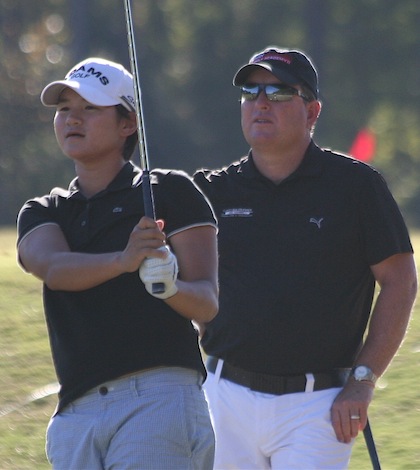
I am always asked what’s the best swing.
I’ve long believed that the best golf swing is the one you believe in, because the golfer who understands his swing and knows how to control his ball flight is the one who has the most confidence.
The reason is that every one of us develops our own swing, whether by practicing on our own, or through instruction from one time or another. Though I was initially trained as a technical teacher, I quickly realized that to take golfers to the next level they needed to master more than just technique — they needed a comprehensive training program that incorporated every aspect of being a champion. That’s just what we did with starting the Gary Gilchrist Golf Academy five years ago.
A comprehensive plan for the student includes mental training, fitness training, full swing, short game, on-course strategy focusing and assessing body language, routine and self talk so that the player can build confidence in them selves. That goes for all our students here at GGGA: juniors, amateurs, adults and professionals.
To me, teaching players is not just about technique and instruction. There are so many factors that can contribute to performance on the course, especially a player’s life outside golf. That’s why I consider myself a coach and a mentor over an instructor. I find it to be important to build a relationship with my players so we can openly share information and work together. This philosophy has helped progress the careers of two of my best students: Shanshan Feng and Morgan Hoffmann.
I met the both of them as juniors and helped guide them through their professional careers, and they’ve each had their fair share of success. Shanshan rose, at one point, to No. 3 in the world and won a major in 2012 — the Wegmans LPGA Championship — while Morgan was at one point ranked as the top amateur in the game and is now a young star on the PGA Tour.
But again, it all comes back to the plan for improvement while looking at all areas of a player’s game. The plan always includes individual drills for a player to improve in a certain area. For example, “feet narrow” to build stability in the lower body during the golf swing or “finger down the shaft,” which helps keep a square clubface from the takeaway through impact. Motion drills really accelerate the learning process by improving feel, stability, balance, timing and coordination.
Centered around those drills, the practice plan helps a player focus on the process and build confidence in what they’re working on. This is extremely important.
Most over thinking comes from searching and a lack of understanding, but a quality practice plan is the first step followed by preparation for playing through shaping shots, short game and a good routine. That’s how we keep things simple at GGGA, so the players can enjoy the game.
Training and practicing the right way builds confidence in the player, which will help them improve their scores in competition. Then when it’s time to compete, a player can prepare mentally to win by working on strategy on the course and sticking to their game plan.
This philosophy began when I was charged with developing the first full-time junior golf academy in the world, IMG’s David Leadbetter Junior Golf Academy in the mid-90s. At IMG we won every national title and major USGA events. Growing up in Durban, South Africa, I dreamed of playing pro golf like many juniors. After playing golf for two years at Texas A&M, my dream came true when I won the South African PGA Tour School and started competing against the likes of Ernie Els and Retief Goosen.
I played on South Africa’s elite Sunshine and Winter Tour for five years, and had my fair share of success with three wins. Later, my professional golf interests led me to the David Leadbetter Golf Academy in Florida, where I learned how to teach. My knowledge grew when I assisted David when he taught PGA Tour players such as Nick Price, David Frost, Mark O’Meara, Andy Bean, Ernie Els and the famous Sir Nick Faldo.
After being there for a few years, I started the junior program as the Director of Golf from 1995 to 2004. From there, I oversaw the development of hundreds of elite junior and professional golfers for another three years at the International Junior Golf Academy (IJGA) in Hilton Head Island, S.C., before beginning my own academy in Florida.
In 2007, I founded the Gary Gilchrist Golf Academy in Howey in the Hills, Fla., which we built from the ground up. We started with just a handful of juniors in the beginning and now have become one of the largest and best academies in the world with 70 juniors and some of the game’s best pros from more than a dozen countries — including Yani Tseng, Charles Howell III, D.A. Points, Shanshan Feng, Morgan Hoffmann, Vicky Hurst, Sophie Gustafson and others.
My passion and love for the game gives me the motivation to inspire golfers of all levels to improve and reach their full potential. Golf is a relationship. The more quality time you spend with the game, the more it will reward you and build your character.
- LIKE6
- LEGIT1
- WOW0
- LOL0
- IDHT0
- FLOP0
- OB0
- SHANK0
Instruction
The Wedge Guy: The easiest-to-learn golf basic

My golf learning began with this simple fact – if you don’t have a fundamentally sound hold on the golf club, it is practically impossible for your body to execute a fundamentally sound golf swing. I’m still a big believer that the golf swing is much easier to execute if you begin with the proper hold on the club.
As you might imagine, I come into contact with hundreds of golfers of all skill levels. And it is very rare to see a good player with a bad hold on the golf club. There are some exceptions, for sure, but they are very few and very far between, and they typically have beat so many balls with their poor grip that they’ve found a way to work around it.
The reality of biophysics is that the body moves only in certain ways – and the particulars of the way you hold the golf club can totally prevent a sound swing motion that allows the club to release properly through the impact zone. The wonderful thing is that anyone can learn how to put a fundamentally sound hold on the golf club, and you can practice it anywhere your hands are not otherwise engaged, like watching TV or just sitting and relaxing.
Whether you prefer an overlap, interlock or full-finger (not baseball!) grip on the club, the same fundamentals apply. Here are the major grip faults I see most often, in the order of the frequency:
Mis-aligned hands
By this I mean that the palms of the two hands are not parallel to each other. Too many golfers have a weak left hand and strong right, or vice versa. The easiest way to learn how to hold the club with your palms aligned properly is to grip a plain wooden ruler or yardstick. It forces the hands to align properly and shows you how that feels. If you grip and re-grip a yardstick several times, then grip a club, you’ll see that the learning curve is almost immediate.
The position of the grip in the upper/left hand
I also observe many golfers who have the butt of the grip too far into the heel pad of the upper hand (the left hand for right-handed players). It’s amazing how much easier it is to release the club through the ball if even 1/4-1/2″ of the butt is beyond the left heel pad. Try this yourself to see what I mean. Swing the club freely with just your left hand and notice the difference in its release from when you hold it at the end of the grip, versus gripping down even a half inch.
To help you really understand how this works, go to the range and hit shots with your five-iron gripped down a full inch to make the club the same length as your seven-iron. You will probably see an amazing shot shape difference, and likely not see as much distance loss as you would expect.
Too much lower (right) hand on the club
It seems like almost all golfers of 8-10 handicap or higher have the club too far into the palm of the lower hand, because that feels “good” if you are trying to control the path of the clubhead to the ball. But the golf swing is not an effort to hit at the ball – it is a swing of the club. The proper hold on the club has the grip underneath the pad at the base of the fingers. This will likely feel “weak” to you — like you cannot control the club like that. EXACTLY. You should not be trying to control the club with your lower/master hand.
Gripping too tightly
Nearly all golfers hold the club too tightly, which tenses up the forearms and prevents a proper release of the club through impact. In order for the club to move back and through properly, you must feel that the club is controlled by the last three fingers of the upper hand, and the middle two fingers of the lower hand. If you engage your thumbs and forefingers in “holding” the club, the result will almost always be a grip that is too tight. Try this for yourself. Hold the club in your upper hand only, and squeeze firmly with just the last three fingers, with the forefinger and thumb off the club entirely. You have good control, but your forearms are not tense. Then begin to squeeze down with your thumb and forefinger and observe the tensing of the entire forearm. This is the way we are made, so the key to preventing tenseness in the arms is to hold the club very lightly with the “pinchers” — the thumbs and forefingers.
So, those are what I believe are the four fundamentals of a good grip. Anyone can learn them in their home or office very quickly. There is no easier way to improve your ball striking consistency and add distance than giving more attention to the way you hold the golf club.
More from the Wedge Guy
- The Wedge Guy: Golf mastery begins with your wedge game
- The Wedge Guy: Why golf is 20 times harder than brain surgery
- The Wedge Guy: Musings on the golf ball rollback
- LIKE86
- LEGIT13
- WOW6
- LOL1
- IDHT0
- FLOP4
- OB1
- SHANK8
Instruction
Clement: Stop ripping off your swing with this drill!

Not the dreaded headcover under the armpit drill! As if your body is defective and can’t function by itself! Have you seen how incredible the human machine is with all the incredible feats of agility all kinds of athletes are accomplishing? You think your body is so defective (the good Lord is laughing his head off at you) that it needs a headcover tucked under the armpit so you can swing like T-Rex?
- LIKE0
- LEGIT2
- WOW2
- LOL0
- IDHT0
- FLOP0
- OB0
- SHANK2
Instruction
How a towel can fix your golf swing
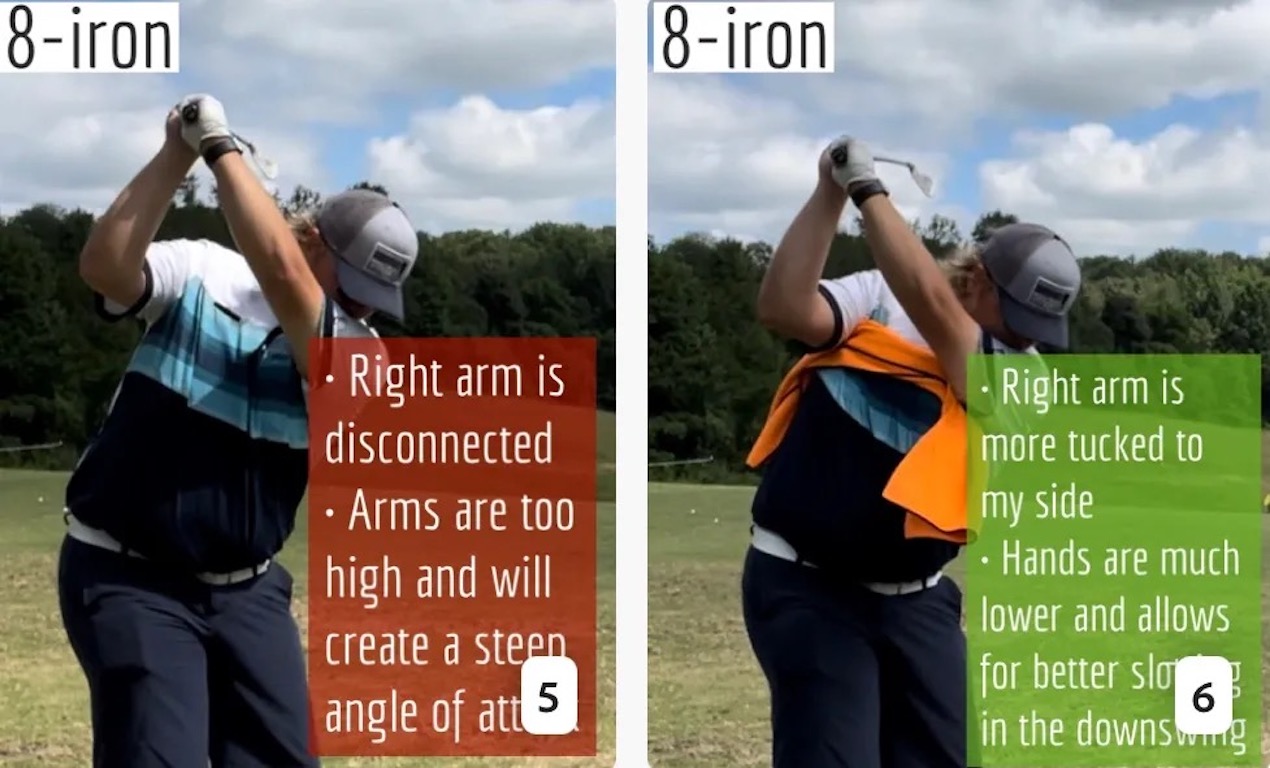
This is a classic drill that has been used for decades. However, the world of marketed training aids has grown so much during that time that this simple practice has been virtually forgotten. Because why teach people how to play golf using everyday items when you can create and sell a product that reinforces the same thing? Nevertheless, I am here to give you helpful advice without running to the nearest Edwin Watts or adding something to your Amazon cart.
For the “scoring clubs,” having a solid connection between the arms and body during the swing, especially through impact, is paramount to creating long-lasting consistency. And keeping that connection throughout the swing helps rotate the shoulders more to generate more power to help you hit it farther. So, how does this drill work, and what will your game benefit from it? Well, let’s get into it.
Setup
You can use this for basic chip shots up to complete swings. I use this with every club in my bag, up to a 9 or 8-iron. It’s natural to create incrementally more separation between the arms and body as you progress up the set. So doing this with a high iron or a wood is not recommended.
While you set up to hit a ball, simply tuck the towel underneath both armpits. The length of the towel will determine how tight it will be across your chest but don’t make it so loose that it gets in the way of your vision. After both sides are tucked, make some focused swings, keeping both arms firmly connected to the body during the backswing and follow through. (Note: It’s normal to lose connection on your lead arm during your finishing pose.) When you’re ready, put a ball in the way of those swings and get to work.
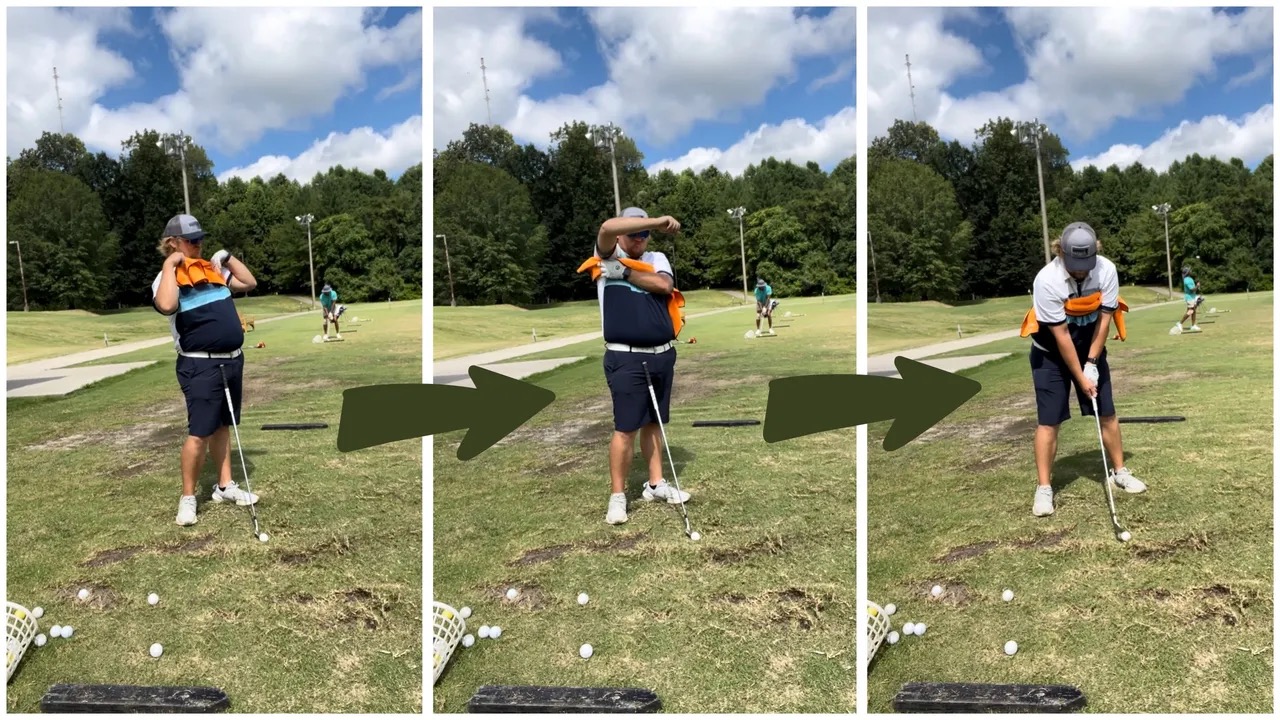
Get a Better Shoulder Turn
Many of us struggle to have proper shoulder rotation in our golf swing, especially during long layoffs. Making a swing that is all arms and no shoulders is a surefire way to have less control with wedges and less distance with full swings. Notice how I can get in a similar-looking position in both 60° wedge photos. However, one is weak and uncontrollable, while the other is strong and connected. One allows me to use my larger muscles to create my swing, and one doesn’t. The follow-through is another critical point where having a good connection, as well as solid shoulder rotation, is a must. This drill is great for those who tend to have a “chicken wing” form in their lead arm, which happens when it becomes separated from the body through impact.
In full swings, getting your shoulders to rotate in your golf swing is a great way to reinforce proper weight distribution. If your swing is all arms, it’s much harder to get your weight to naturally shift to the inside part of your trail foot in the backswing. Sure, you could make the mistake of “sliding” to get weight on your back foot, but that doesn’t fix the issue. You must turn into your trial leg to generate power. Additionally, look at the difference in separation between my hands and my head in the 8-iron examples. The green picture has more separation and has my hands lower. This will help me lessen my angle of attack and make it easier to hit the inside part of the golf ball, rather than the over-the-top move that the other picture produces.
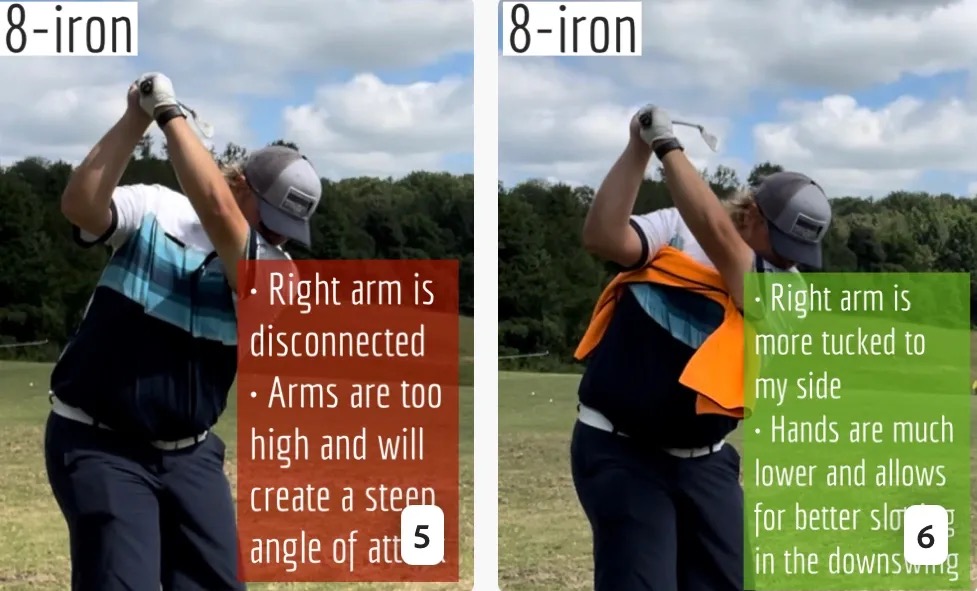
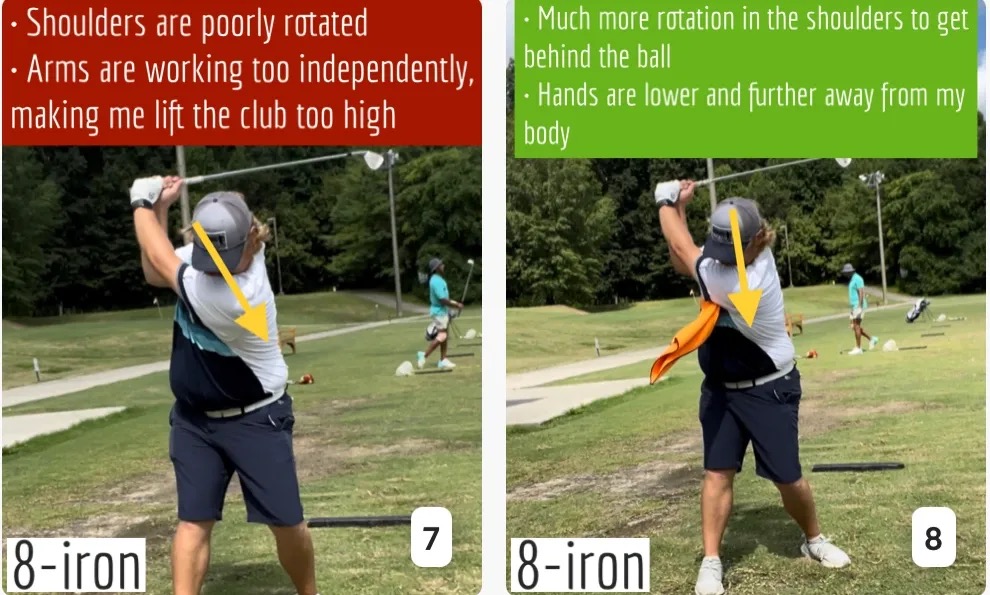
Stay Better Connected in the Backswing
When you don’t keep everything in your upper body working as one, getting to a good spot at the top of your swing is very hard to do. It would take impeccable timing along with great hand-eye coordination to hit quality shots with any sort of regularity if the arms are working separately from the body.
Notice in the red pictures of both my 60-degree wedge and 8-iron how high my hands are and the fact you can clearly see my shoulder through the gap in my arms. That has happened because the right arm, just above my elbow, has become totally disconnected from my body. That separation causes me to lift my hands as well as lose some of the extension in my left arm. This has been corrected in the green pictures by using this drill to reinforce that connection. It will also make you focus on keeping the lead arm close to your body as well. Because the moment either one loses that relationship, the towel falls.
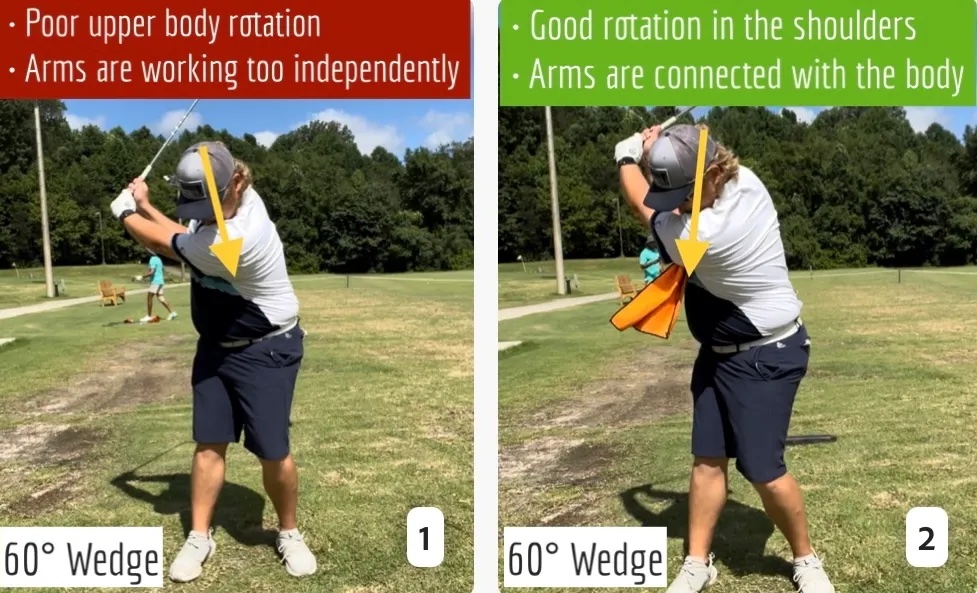
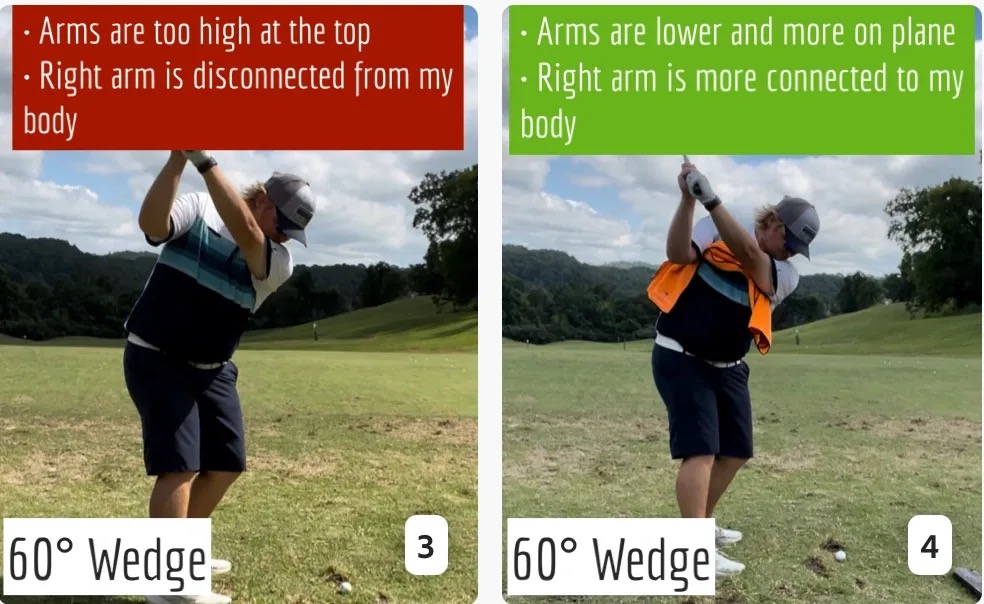
Conclusion
I have been diligent this year in finding a few drills that target some of the issues that plague my golf game; either by simply forgetting fundamental things or by coming to terms with the faults that have bitten me my whole career. I have found that having a few drills to fall back on to reinforce certain feelings helps me find my game a little easier, and the “towel drill” is most definitely one of them.
- LIKE12
- LEGIT2
- WOW2
- LOL0
- IDHT0
- FLOP2
- OB0
- SHANK8
-

 19th Hole2 weeks ago
19th Hole2 weeks agoDave Portnoy places monstrous outright bet for the 2024 Masters
-

 19th Hole2 weeks ago
19th Hole2 weeks agoTiger Woods arrives at 2024 Masters equipped with a putter that may surprise you
-

 19th Hole21 hours ago
19th Hole21 hours ago‘Absolutely crazy’ – Major champ lays into Patrick Cantlay over his decision on final hole of RBC Heritage
-

 19th Hole3 weeks ago
19th Hole3 weeks agoReport: Tiger Woods has ‘eliminated sex’ in preparation for the 2024 Masters
-

 19th Hole1 week ago
19th Hole1 week agoTwo star names reportedly blanked Jon Rahm all week at the Masters
-

 19th Hole1 week ago
19th Hole1 week agoReport: LIV Golf identifies latest star name they hope to sign to breakaway tour
-

 19th Hole1 week ago
19th Hole1 week agoNeal Shipley presser ends in awkward fashion after reporter claims Tiger handed him note on 8th fairway
-

 19th Hole6 days ago
19th Hole6 days agoBrandel Chamblee has ‘no doubt’ who started the McIlroy/LIV rumor and why
















Adh
Jul 27, 2014 at 9:36 am
Great guy, but picked up the news that he is probably selling out to Img academy. Sad but true…..
putty
Jun 13, 2013 at 12:05 am
Yea hes done with Gilcrest he is back with Grant Waite
James
Jun 12, 2013 at 11:49 am
That’s funny because Gary did a photo shoot for a major golf publication with Charles Howell within that last month.
Putty
Jun 12, 2013 at 8:17 am
That’s funny because as of last month Charles Howell no longer has Gary as his swing coach. Saw on twitter it’s Grant Waite.
Marty
Jun 11, 2013 at 11:39 pm
Sounds like ad copy to me.
JFG
Jun 11, 2013 at 10:43 pm
As an adult I go to the Academy for 1/2 day each month.. and between the fitness and swing coaching I am getting better and better!! The coaching team and support team are great!! It is amazing to see the youngsters as well as the Pros working out on the range. 🙂
JK
Jun 11, 2013 at 8:28 pm
I would have killed to have had some formal training at any point in my life prior to when I was 27, which is when I took my first golf lesson, and I was already a 1.5 handicap. I have bloomed way too late to make a difference. These kinds of resources were not available during my childhood. It’s great that they’re starting to become more commonplace.
Brian
Jun 11, 2013 at 3:58 pm
Paul. The expenses and fees to run a full time academy are extremely high. I have been in the junior golf industry for over 18 years. All the junior full time academies are expensive. Some a little more money than others. Remember you get what you pay for. Four years of college costs roughly $40,000 – $60,000 a year. One year at GGGA will develop a student athlete to earn the college golf scholarship. So if you pay say $60,000 you end up saving $100,000. Problem most of us have are the total start up costs for private school, tournaments and the academy.
paul
Sep 21, 2013 at 9:35 pm
Not like that here in Canada. tuition is about $6000/ year.
paul
Jun 11, 2013 at 2:45 pm
It would be easier to live up to our potential as golfers if it was more affordable.